Friday, December 08, 2006
Ready for Winter
I find that half of the effort is getting to the area where we normally do art, and the other half is producing the piece itself. It is easier for me to paint during the winter, nothing outside is calling my attention. It is also easier to reflect on what I've done.
Saturday, December 02, 2006
Artificial Light
 I had an ill-founded mistrust of artificial light. For years I did not even entertain the thought. I was afraid of what incandescent light bulbs would do to my colors. In my mind, I would wake up the next day, take a look at my watercolor, and shriek in horror at the ghastly color schemes. But it was during the storms of El Nino that I had force myself to work at night. Winters in the San Francisco Bay Area are wet and dark. Storms follow each other seamlessly, and the pallor of daylight is not strong enough to coax much color saturation. That winter we had so many straight days of rain, that I got tired of waiting for a reprieve and pulled out my tubes, uncertain of what I was going to do. I ended up painting still lives directly under the light, and, to my surprise, the results were not jarring the morning after.
I had an ill-founded mistrust of artificial light. For years I did not even entertain the thought. I was afraid of what incandescent light bulbs would do to my colors. In my mind, I would wake up the next day, take a look at my watercolor, and shriek in horror at the ghastly color schemes. But it was during the storms of El Nino that I had force myself to work at night. Winters in the San Francisco Bay Area are wet and dark. Storms follow each other seamlessly, and the pallor of daylight is not strong enough to coax much color saturation. That winter we had so many straight days of rain, that I got tired of waiting for a reprieve and pulled out my tubes, uncertain of what I was going to do. I ended up painting still lives directly under the light, and, to my surprise, the results were not jarring the morning after.Since then, I've relaxed. I've taught myself to analyze light the same way I analyze light during the daytime. I know, for example, not just that everything will be bathed in a certain yellow, but that some shadows will be greenish and others, bluish. Because of the relative lack of reflected light in the surroundings, these shadows will seem darker and deeper than similar ones cast in the daytime. Polished surfaces lose some of their shine, and glossy surfaces will not show that patch of bluish white where light hits them.
The still life shown here (16 x 20), was done on a hotel room desk. I was tempted to add more objects, but I only had two hours; I was tired. I had stolen a guava from the botanical gardens, collected the passion fruits from the ground in Hana, and bought the papaya at a health market in Paia, Maui. For the shadows, intead of the cobalt blue I use in sunny days, I used indigo. The light is all suffused in cadmium yellow medium. There are no pure white spaces. The paper bag was done with burnt sienna and burnt ochre. I don't love the way I ended up depicting it, which I attribute to the fact I was exhausted, but I love the guava. The next day I ate it, but it was too sour.
Monday, November 27, 2006
Citizen Artist
I swore off art as a career the day I visited the San Francisco Art Institute to clear up a misunderstanding with their financial aid department. I had been admitted, but also been told the SFAI graduate program did not grant financial aid to non-citizens (I still have the letter). So I waited until arrival in San Francisco to clear up the matter. Apparently they had not heard that Puerto Ricans had been made American citizens prior to the Korean War.
But something happened once I got to the SFAI campus. I could not find the financial aid office, so I walked all over, through their exhibits, classrooms, and administrative offices. Tuition was in the vicinity of $15,000 a year in 1985, and I was asking myself the question "Ok, what do I get for $15,000.?" I sat on a bench in one of their open spaces on the second floor. The view was beautiful, and, as I appreciated the surroundings, I decided right there that I didn't want to pay $35,000. to become a conceptual artist. After this bold insight, I got up and was able to locate the elderly officer of their financial aid office. Just as I thought, she assumed I had applied from Costa Rica. In my awkward English, I told her not to bother.
Was that a good decision? What it terrible to reject the credibility that comes with a SF Art Institute degree? I have often asked myself the same question over the years. Let me know what you think.
Saturday, November 25, 2006
Paris, Las Vegas
 Since I haven't yet gone to the real Paris, I reasoned, Paris Las Vegas, the hotel, will do. I stationed myself at a corner wedged between the hotel wall and the fountain. The fountain was inspired on the one at the Place de la Concorde, which in turn was inspired on the ones at Saint Peter's Square in the Vatican. Nothing is new.
Since I haven't yet gone to the real Paris, I reasoned, Paris Las Vegas, the hotel, will do. I stationed myself at a corner wedged between the hotel wall and the fountain. The fountain was inspired on the one at the Place de la Concorde, which in turn was inspired on the ones at Saint Peter's Square in the Vatican. Nothing is new.The falling water's roar was almost unbearable, and the mist made everything colder. In short, I was in my element, so I started painting, happy to be away from cigarette smoke and protected from the maddening crowds. Andrea Bocelli's voice reached me from across the street and thick traffic, and suddenly, the heads of every passer-by turned to face its origin. The huge fountain at the Bellagio had been activated.
I could now focus on the problem at hand. After the pencil drawing I could see the statues would steal the show, but I wanted to fight against my tendency to include too much background detail. Even though they occupied most of the space in the 12 x 12" Aquarello (Cartiera Magnani) sheet, I knew that the manner in which I treated the background would "make or break" this picture. So I asked myself: What do I simplify, and how do I do it?
I omitted most of the people walking within my line of view. I could not rely on spectators staying there long enough for me to paint them. I also used a purple wash over all of the background, except for the sky. Speaking of the sky, I left out the majority of the clouds, too wispy and white to make it in this "battle of the values." Finally, I left out some signs on the street which I thought would be distracting.
My approach varies. Sometimes I do the background first, sometimes the foreground. Sometimes I work on both simultaneously, especially if I am not yet sure of whether there will be enough contrast. In this picture, I did exactly that. It was a cold palette, reflective of the cold day it was.
Yes, But
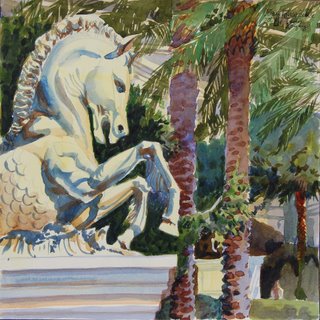
Saturday, November 11, 2006
More Maui


Painting in Maui


- a pocket box (I fill it with my own colors)
- plastic mixing pan about 7" x 10"
- foldable water "bucket"
- three brushes in their own case
- 12" x 16" block of paper
- mechanical pencil (never needs sharpening)
- plastic container with my paint tubes
- small natural sponge
- one bottle of water for each painting
- kneadable eraser
- paper towels
- hat, shades, sunscreen
Good Quality
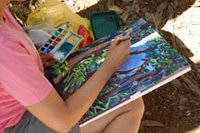
Friday, November 10, 2006
Plein Air
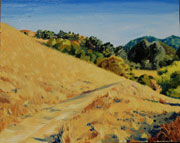
 I took advantage of the mild October weather (read: not rainy) to do a couple of quick oils in the park behind our house. Finding a cow-free spot requires a mile-long trek uphill through hot dusty fireroads. I normally take a $30. aluminum portable easel, a hat, a snack, a bottle of water, my sunglasses, a long sleeved shirt, and a foldable chair that doubles as backpack. Inside are no more than six tubes of basic colors, a pad of disposable palette paper, some turpentine, a set of about 20 hog brushes, a bit of stand oil, and some rags. Sometimes I bring a pencil, but most of the time I forget.
I took advantage of the mild October weather (read: not rainy) to do a couple of quick oils in the park behind our house. Finding a cow-free spot requires a mile-long trek uphill through hot dusty fireroads. I normally take a $30. aluminum portable easel, a hat, a snack, a bottle of water, my sunglasses, a long sleeved shirt, and a foldable chair that doubles as backpack. Inside are no more than six tubes of basic colors, a pad of disposable palette paper, some turpentine, a set of about 20 hog brushes, a bit of stand oil, and some rags. Sometimes I bring a pencil, but most of the time I forget.
Thursday, October 26, 2006
Of Patience and Persistence
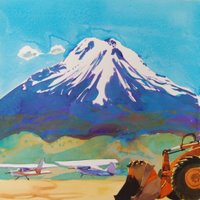 I have learned that my eyes need some "aclimatizing" before they can attempt to register the full range of color, hue and value in an outdoor scene. I have a hard time describing the process. My color perception appears to be highly correlated to the amount of time spent at a location, whether I'm wearing shades or spend time indoors. So I do not try to paint right after arrival. I wait at least a day or two if I can manage.
I have learned that my eyes need some "aclimatizing" before they can attempt to register the full range of color, hue and value in an outdoor scene. I have a hard time describing the process. My color perception appears to be highly correlated to the amount of time spent at a location, whether I'm wearing shades or spend time indoors. So I do not try to paint right after arrival. I wait at least a day or two if I can manage.But what if I'm just passing by? I was finally able to paint something more satisfactory after the fourth try. In this painting, I got rid of Payne's gray and used purple to define Shasta. The hills are suggested by two baseline transparencies (yellow ocre and a turquoise blue) overlapping at the horizon. But I had the most fun with the bobcat. I love mechanical objects. If you do watercolor, you will notice the sky's wash is quite imperfect. I have stopped trying to create perfect flat areas of color unless the painting calls for it. To me, it is what gives the medium its own vulnerability and appeal, otherwise, little will distinguish it from silkscreen or Flash.
Tuesday, October 24, 2006
Small Pieces

We were very broke upon arrival from my visit to Brazil in 1991. I threw myself into obtaining a teaching credential and later into graduate school. Watercolor was the only media I worked on during these years. I used the 7 x 10 blocks, or cut larger sheets to these dimensions. At times I also used 10 x 14. Because my work is usually not based on photographs, the larger formats seemed inconvenient; they took way longer to execute. I loved painting people, but it was very hard to catch them for more than a few seconds. So the small size enabled me to catch an impression.
Later on, I learned to “resolve” the issue of detail in my larger pieces. After I started working in oils again, this media helped me realize I could suggest instead of document. As a result, I started experimenting with much larger sizes, up to 22 x 30.
I also learned that watercolor society curators would not consider works under that gargantuan dimension, so I tried... and failed. In retrospect, none of those big pieces seems satisfactory to me. 22 x 30 is a studio, not plein air size. You need time and entire pans of color to make it work. You need a table. I went back to 10 x 14.
Currently, I still cut large sheets in half or quarters. 140 lb paper rarely curls anyway, so I seldom carry more than the tubes, a mixing pan, and my two brushes when I go out.
Monday, October 23, 2006
Details, Details, Details

I've been busy "inventorying" (does this word exist?) my work of the last five years. Yes, I have been lazy, I'm one of those people who don't even sign most of their work because they think they'll go back and "resolve" whatever issues later on. So, if I don't even sign my own work, coming up with a title, media, dimensions, and value feels even more troublesome. But now that I am getting ready to market my work (see how ugly that word feels?) I need to have an inventory. So I've used Excel to create a primitive list.
I've had to go back and measure my oils, and try to remember in what paper did I do those watercolors from a few years back. But that's easy, I've been in love with Lanaquarelle for some time now. I don't even have flat files! I have many portfolios where I keep my works on paper. All very confusing and not much of a system.
Sunday, October 15, 2006
Still Life

Still life is difficult. Just yesterday I started one in acrylic and I stopped. I am so used to oil now that the acrylic painting proved to be too hard for me to tackle. Am I being overly ambitious by crowding it with too many objects? Should I do it at a time when the light does not change so rapidly? I set this one up on the table where I normally keep the miter cutter.
Friday, October 13, 2006
Figure Drawing


These are 20 minute poses done in a more restricted palette, Paine's Gray, Burnt Sienna, and Sap Green. But this paper could not take light erasing (it behaved as if it had lost its sizing) so I am going back to Lanaquarelle. This means I will beat myself over the "bad" watercolors one inevitably produces during a three-hour session, because good paper is so expensive. You are looking at the good ones. I don't photograph the bad ones.
I love this model. You can see all of her bones and muscles.
Oil-In-Progress
20 Minute Figure Drawing




This semester I thought I'd keep myself sharp by taking a figure drawing class at the Richmond Art Center, which is very close to where I live. I really wanted to bring my watercolors and acrylics, but wasn't sure what kind of class it would be. I didn't need to worry, as instructor Laura Paulini was very accepting of anything which furthers self-expression and a search for knowledge. So after the first couple of classes, I began using ink, and later, watercolors.
The longest poses are twenty minutes! That's a short time... If you're using watercolor, consider that sometimes you may want paint to dry before you add a transparent layer. All cannot be done wet-on-wet. In the first few I was using a Velasquez palette, but soon abandoned this approach in favor of something a bit more restricted (two colors), which takes less time. I spend about 7 of those first twenty minutes measuring and drawing with a pencil. I could work without the pencil drawing too, but it takes longer.
So in these quick pieces I have been dealing with the problem of how to interpret the human body in a very short time frame, using a liquid medium. This context makes the work wonderfully loose and unpredictable, even with cheap paper.
Friday, October 06, 2006
Oil-In-Progress

I had a chance to work some more on the migrant worker's portrait. I added the background and worked on the chair. I have been debating on what to do with the background for a while. I wanted it to tell a story, then I scraped that idea and decided to just do the exact background in the studio, which includes objects completely unrelated to the sitter's life. So now I am getting ready to do just that. I won't mess with "reality" until I have a much better idea of why I am doing it. Probably later, during the next few portraits.
Thursday, October 05, 2006
Where I Started
 Two years ago I had a very stressful job and decided to return to oil painting. I had been doing watercolors all these years but had never had the space to commit to larger works. So I decided to experiment and converted a shack in my Sacramento yard into a studio. The pieces I completed during this time reflect the beautiful sunlight of the region.
Two years ago I had a very stressful job and decided to return to oil painting. I had been doing watercolors all these years but had never had the space to commit to larger works. So I decided to experiment and converted a shack in my Sacramento yard into a studio. The pieces I completed during this time reflect the beautiful sunlight of the region.
An 80 square feet shack soom became too small, so when we returned to the Bay Area my partner and I looked for a garage I could use. The home we eventually found had a very old, termite ridden garage, which we remodeled. I went from 80 to 400 sq feet, which was the maximum my budget allowed.
Sunday, October 01, 2006
Oil-In-Progress
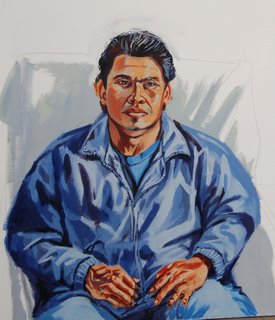 I am working on a series about migrant workers, many of whom congregate at the home improvement warehouse about five minutes away from my studio. Here you see the results of five and a half hours of back-breaking work. I have to start and finish on the same day because models are often not available again the following day. I will work on the background later this week, and post a photo of the finished piece.
I am working on a series about migrant workers, many of whom congregate at the home improvement warehouse about five minutes away from my studio. Here you see the results of five and a half hours of back-breaking work. I have to start and finish on the same day because models are often not available again the following day. I will work on the background later this week, and post a photo of the finished piece.The hardest thing is to explain, in Spanish, that they will get paid for "just sitting." I pay the standard rate they would receive if they were out there doing their usual work. I also translate the contents of the model release form, and give them a photo of the painting.
